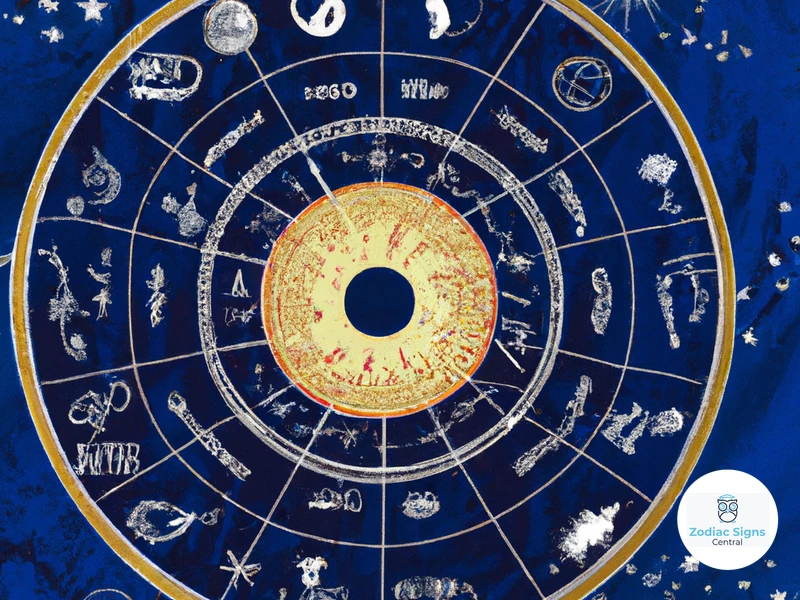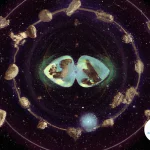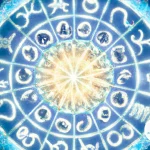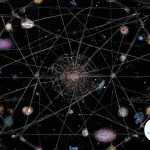Plunge into the captivating realm of astrology and unlock the secrets hidden within a birth chart. As you embark on this mystical journey, you’ll discover the power of deciphering the positions and movements of celestial bodies at the moment of your birth. Understanding how to read and analyze a birth chart is a skill that allows you to gain profound insights into your personality, characteristics, and life path. This comprehensive guide will walk you through the step-by-step process, providing you with the tools and knowledge to unravel the complex tapestry of your birth chart. So, get ready to delve into a world where symbols, planets, and patterns converge, ultimately revealing the unique blueprint of your destiny.
What is a Birth Chart?
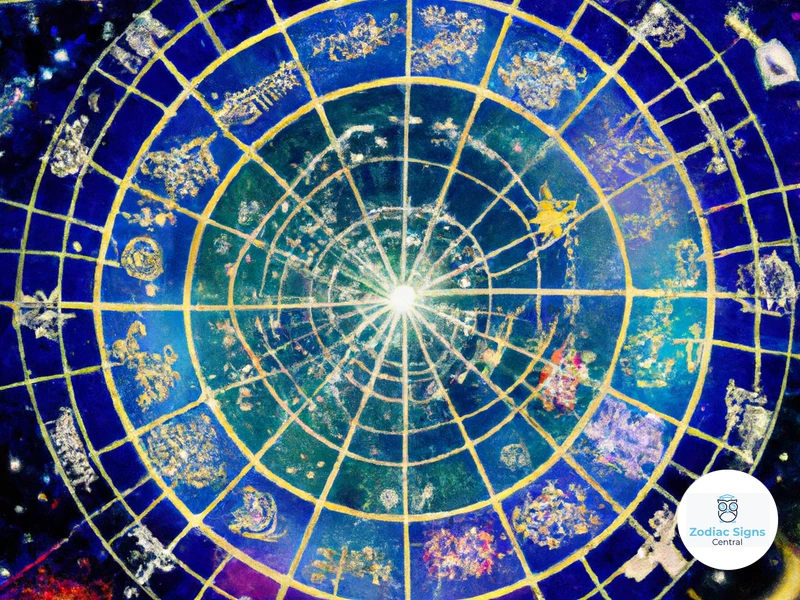
A birth chart is a detailed map of the celestial bodies’ positions at the exact moment of an individual’s birth. It serves as a cosmic snapshot, capturing the unique alignment of the planets, the Sun, the Moon, and other celestial bodies. Each birth chart is essentially a personalized astrological portrait that reflects an individual’s personality, potential, and life experiences.
1. Definition and Purpose
A birth chart is also known as a natal chart or horoscope. It is a fundamental tool used in astrology to gain insights into a person’s character, strengths, weaknesses, and life path. The birth chart is based on the belief that the positions of the planets and other celestial bodies at the time of birth can influence an individual’s personality and shape their destiny.
2. Components of a Birth Chart
A birth chart consists of various elements, including the Sun sign, Moon sign, Rising sign (Ascendant), and the positions of the planets in the different houses of the zodiac. Each of these components carries significance and contributes to the overall interpretation of the birth chart.
3. Importance of Birth Charts in Astrology
Birth charts are essential in astrology as they provide a blueprint of an individual’s unique energy and potential. By studying and interpreting a birth chart, astrologers can provide detailed insights into an individual’s personality traits, strengths, challenges, and life patterns. Birth charts are also used to forecast future trends and events, making them invaluable tools for self-awareness, personal growth, and decision-making.
Understanding the intricacies of a birth chart is the key to unraveling the mysteries of astrology and unlocking the profound insights it can offer. By examining each component and understanding their interplay, you can begin to decode the hidden messages and gain a deeper understanding of yourself and your life’s path. So, let’s embark on this cosmic journey together.
1. Definition and Purpose
A birth chart, also known as a natal chart or horoscope, serves as a roadmap of the celestial bodies’ positions at the exact moment of an individual’s birth. It is a fundamental tool in astrology that holds a profound purpose in understanding the unique energy and potential of a person. The birth chart provides insights into an individual’s character, strengths, weaknesses, and life path, all based on the belief that the positions of the planets and other celestial bodies at the time of birth influence one’s personality and shape their destiny.
To better grasp the concept of a birth chart, let’s break it down into its definition and purpose:
Definition: A birth chart is a comprehensive astrological representation of an individual’s cosmic imprint at the exact moment of their birth. It is calculated using the date, time, and location of birth. The chart plots the placement of the Sun, Moon, planets, and other celestial bodies within the twelve houses of the zodiac, creating a unique snapshot of the individual’s astrological profile.
Purpose: The purpose of a birth chart is multifaceted. First and foremost, it serves as a tool for self-discovery and self-awareness. By understanding the various components and interpretations within the birth chart, individuals can gain insights into their personality traits, inclinations, and potential life experiences. The birth chart provides a deeper understanding of one’s strengths and weaknesses, helping individuals navigate personal growth and development.
Additionally, birth charts allow astrologers to make predictions about the individual’s life based on the planetary placements and aspects within the chart. This includes forecasting upcoming trends, opportunities, and challenges. The birth chart acts as a guide for decision-making, helping individuals align their actions with their cosmic blueprint.
Understanding the definition and purpose of a birth chart is the foundation for delving into its intricate details and unlocking the rich insights it holds. In the next sections, we will explore the various components of a birth chart and the step-by-step process of reading and analyzing it. So, let’s dig deeper into the wonders of astrology and unravel the mysteries of your birth chart.
2. Components of a Birth Chart
A birth chart comprises several essential components that work together to create a comprehensive astrological profile. Each element provides valuable information about an individual’s personality, life, and potential.
Sun Sign: The Sun sign represents the core essence of a person’s identity and character. It indicates the broad traits and characteristics that shape an individual’s personality. For example, those born under fire signs like Aries, Leo, and Sagittarius are known for their passionate and energetic nature.
Moon Sign: The Moon sign reflects an individual’s emotional nature and their deeply internalized needs. It reveals how a person responds emotionally to situations and their instinctive behaviors. Understanding the Moon sign can provide insights into an individual’s relationships, habits, and emotional well-being.
Rising Sign (Ascendant): The Rising sign, also known as the Ascendant, represents the persona an individual presents to the outside world. It governs the individual’s physical appearance, style, and first impressions. The Rising sign plays a significant role in determining how others perceive and interact with an individual.
Planetary Placements: The positions of the planets in the birth chart indicate various aspects of an individual’s life. Each planet represents different areas, such as love, career, communication, and spirituality. Analyzing the planets’ placements can provide insights into an individual’s strengths, challenges, and opportunities in these specific areas.
By understanding and interpreting the components of a birth chart, astrologers can offer a comprehensive analysis of an individual’s personality, relationships, and life experiences. The combination of these elements creates a unique astrological fingerprint that reveals the intricate complexities of one’s existence. So, let’s dive deeper into the individual components and explore the messages they hold within the celestial tapestry of your birth chart. (No relevant anchor text for this section)
3. Importance of Birth Charts in Astrology
Birth charts hold immense importance in the world of astrology as they serve as a valuable tool for self-discovery, personal growth, and understanding the interplay between celestial energies and individual lives. Here are a few reasons why birth charts are considered vital in astrology:
3.1 Personalized Insight: A birth chart provides personalized insights into an individual’s character, traits, strengths, weaknesses, and potentials. By analyzing the positions of the planets and other celestial bodies at the time of birth, astrologers can unveil unique aspects of a person’s personality and shed light on their motivations and tendencies. It offers a deeper understanding of oneself and can aid in personal growth and self-acceptance.
3.2 Life Path and Purpose: Birth charts act as roadmaps, revealing the potential life path and purpose of an individual. By examining the placements of various celestial bodies and their aspects, astrologers can identify patterns, recurring themes, and life lessons. This knowledge can empower individuals to make informed decisions, embrace opportunities, and navigate life’s challenges with a sense of direction.
3.3 Relationship Dynamics: Birth charts play a crucial role in understanding the dynamics and compatibility between individuals. Comparing the birth charts of two people can provide insights into the strengths and challenges of their relationship. Astrologers can study the aspects between their planets, compatibility of their elements and modalities, and how their individual traits may interact. This knowledge can support individuals in forming healthy, harmonious relationships.
3.4 Timing and Forecasting: Birth charts are used to forecast future trends, events, and cycles. Astrologers can analyze the transits of planets and their interactions with an individual’s natal chart to predict significant life events, career opportunities, relationship developments, and personal growth phases. This information can help individuals make informed decisions, seize auspicious moments, and navigate challenges effectively.
Understanding the importance of birth charts in astrology opens up a world of self-awareness and guidance. It allows individuals to embrace their unique qualities, align with their life’s purpose, and make conscious choices in various aspects of life. So, let’s explore the intricacies of birth chart analysis and unlock the wisdom hidden within the cosmic patterns.
How to Read and Analyze a Birth Chart
When it comes to reading and analyzing a birth chart, it’s essential to follow a systematic approach. By breaking down the process into steps, you can gain a comprehensive understanding of the various components and their significance. Here is a step-by-step guide to help you navigate the intricate world of birth chart interpretation:
1. Gather Accurate Birth Information
Begin by gathering accurate birth information such as the date, time, and place of birth. This data is crucial for drawing an accurate birth chart. Without precise information, the interpretation may be skewed or incomplete.
2. Identify the Ascendant
The Ascendant, also known as the Rising Sign, indicates the individual’s outward personality and how they present themselves to the world. To determine the Ascendant, you need to know the exact time and place of birth. The Ascendant sign sets the tone for the entire birth chart, providing valuable insights into the individual’s appearance, demeanor, and initial impressions.
3. Interpret the Sun Sign
The Sun Sign represents the core essence of an individual’s identity. It signifies the person’s ego, vitality, and overall life purpose. Understand the characteristics and traits associated with the Sun Sign to gain insights into the individual’s fundamental nature and motivations. You can explore more about Sun Signs in the article on fire signs that includes Aries, Leo, and Sagittarius, known for their passionate and energetic nature.
4. Examine the Moon Sign
The Moon Sign represents an individual’s emotional nature, instincts, and subconscious mind. It reveals how one responds emotionally and the kind of nurturing they require. Analyzing the Moon Sign helps unravel deep-seated emotional patterns and desires.
5. Analyze the Planetary Placements
Next, focus on the positions of the planets in the birth chart. This step involves studying the relationship between the Sun, Moon, and Rising Sign as they form the foundation of an individual’s identity. Additionally, observe the placement of other planets in the various houses of the birth chart. Each planet’s position provides valuable insights into different aspects of an individual’s life. Look for aspects and conjunctions between planets as they highlight the interactions and influences between different planetary energies. Understanding these dynamics adds depth to the birth chart analysis.
6. Evaluate the Elements and Modalities
The elements (fire, earth, air, and water) and modalities (cardinal, fixed, and mutable) in the birth chart play a vital role in understanding an individual’s temperament, behavior, and approach to life. Assess the distribution and balance of these elements and modalities to gain a holistic view of the individual’s personality.
7. Consider the Birth Chart Patterns
Birth chart patterns, such as stelliums, grand trines, or T-squares, indicate specific formations and concentrations of energy within the chart. These patterns provide valuable insights into the individual’s strengths, challenges, and potential life paths. Analyzing the birth chart patterns adds another layer of understanding to the overall interpretation.
By following these steps, you can begin decoding the intricacies of a birth chart and gain a profound understanding of an individual’s unique cosmic essence. Remember that birth chart analysis is a lifelong journey of self-discovery and growth, and it is always beneficial to seek the guidance of experienced astrologers or refer to reliable resources for a comprehensive interpretation.
1. Gather Accurate Birth Information
To begin the process of reading and analyzing a birth chart, it is crucial to gather accurate birth information. This includes the date, time, and location of an individual’s birth. The date of birth determines the Sun sign, which is the core essence of one’s personality. The time of birth is essential for determining the Ascendant or Rising sign, which represents the external mask and first impression a person gives to the world. The location of birth is needed to determine the geographic coordinates, which help in calculating the positions of the planets accurately.
Accurate birth information ensures precise calculations and interpretations, providing a solid foundation for the birth chart analysis. If you are unsure about your birth time, it is recommended to seek official records such as birth certificates or consult with family members who may have knowledge of the exact time. Remember, even a few minutes here or there can significantly impact the placement of the Ascendant and the entire birth chart interpretation.
Gathering accurate birth information sets the stage for a reliable and insightful birth chart reading. Once you have this essential data, you can proceed to explore the fascinating realms of astrology and uncover the secrets that lie within your unique cosmic blueprint. So, take the time to gather your birth details accurately, and let the journey of self-discovery begin.
2. Identify the Ascendant
In astrology, the Ascendant, also known as the Rising sign, is a crucial component of the birth chart. It represents the zodiac sign that was rising on the eastern horizon at the precise moment of your birth. To identify the Ascendant, you need to know the exact time and location of your birth.
The Ascendant plays a significant role in determining the individual’s outward appearance, first impressions, and overall approach to life. It represents the mask we wear and how we interact with the world. To determine your Ascendant sign, you can use an online birth chart calculator or consult an astrologer.
Once you have identified your Ascendant, you can explore its traits and characteristics. For example, if your Ascendant is in one of the cardinal signs—Aries, Cancer, Libra, or Capricorn—you may possess leadership qualities and have a strong desire for initiating action and taking charge. Understanding the influence of your Ascendant can provide valuable insights into how you present yourself to the world.
The Ascendant also sets the stage for the positioning and interpretation of the other planets in your birth chart. It establishes the starting point for the twelve houses and determines how they intersect with the zodiac signs. While the Sun sign represents your core essence and the Moon sign reflects your emotional nature, the Ascendant showcases the external persona you project to the world.
Identifying and exploring your Ascendant sign is an essential step in reading and analyzing your birth chart. It sets the tone for understanding the various aspects of your personality and how they manifest in everyday life. So, take the time to uncover this integral part of your astrological makeup and delve deeper into the secrets that lie within.
3. Interpret the Sun Sign
The Sun sign is one of the most well-known and easily identifiable aspects of a birth chart. It represents the core essence of an individual’s personality and their ego. Interpreting the Sun sign provides valuable insights into a person’s basic characteristics, desires, and motivations.
To interpret the Sun sign, analyze the zodiac sign in which the Sun was positioned at the time of birth. Each sign carries its own unique traits and qualities. For example, fire signs (such as Aries, Leo, and Sagittarius) are known for their passionate and energetic nature, while earth signs (such as Taurus, Virgo, and Capricorn) are grounded, practical, and reliable.
Understanding the characteristics associated with each Sun sign can help you have a better understanding of your own personality as well as the tendencies and inclinations of others. It’s important to remember that while the Sun sign is a significant aspect, it is just one piece of the larger birth chart puzzle. Other elements, such as the Moon sign and rising sign, add depth and nuance to the overall interpretation.
By delving deeper into the nuances of your Sun sign, you can gain a clearer understanding of your strengths, areas for growth, and how you express yourself in the world. It is worth noting that the interpretation of the Sun sign should be done in conjunction with other aspects of the birth chart, as this provides a more comprehensive understanding of an individual’s astrological profile.
So, whether you identify with the fiery vigor of a Leo or resonate with the practicality of a Capricorn, exploring and interpreting your Sun sign can guide you towards a path of self-discovery and personal growth.
(anchor: /astrology-cardinal-sign-traits/)
4. Examine the Moon Sign
In astrology, the Moon sign holds immense significance as it represents an individual’s emotional nature, instincts, and subconscious mind. The Moon sign reflects our deepest needs, desires, and what brings us a sense of emotional fulfillment. To examine the Moon sign in a birth chart, you need to identify the zodiac sign in which the Moon was located at the time of birth.
The Moon sign reveals how we process and respond to emotions, how we nurture ourselves and others, and what makes us feel secure. It impacts our emotional reactions, habits, and instincts. It also influences our relationships with family members and the people we feel most comfortable with. For instance, someone with a Moon in a fire sign like Aries, Leo, or Sagittarius may have a passionate and energetic approach to their emotions, while someone with a Moon in an earth sign like Taurus, Virgo, or Capricorn may be more grounded and practical in their emotional expression.
To fully understand the influence of the Moon sign, it’s essential to consider its aspects, which are the angles it forms with other planets in the birth chart. These aspects provide additional insights into how the Moon’s energy interacts with other planetary energies, shaping an individual’s emotional makeup and reactions.
Analyzing the Moon sign in a birth chart can provide valuable insights into an individual’s emotional needs, inner world, and instinctual responses. Understanding and nurturing these aspects of oneself can lead to emotional well-being and personal growth. So take the time to explore your Moon sign and discover the depth of its influence on your emotional landscape.
Remember, the Moon sign is just one piece of the intricate puzzle that is your birth chart. To gain a comprehensive understanding of your astrological blueprint, it’s crucial to consider all the components and their interconnections.
5. Analyze the Planetary Placements
Analyzing the planetary placements in a birth chart is a crucial step in understanding the unique dynamics and influences at play in an individual’s life. The position of each planet in the birth chart reveals valuable insights about different areas of life, personality traits, and potential challenges.
5.1 Sun, Moon, and Rising Sign
The Sun, Moon, and Rising sign (Ascendant) are considered the three most significant points in a birth chart. The Sun represents the core essence of an individual’s personality, their ego, and the driving force behind their actions. The Moon represents emotions, instincts, and the emotional well-being of a person. The Rising sign, also known as the Ascendant, reflects the mask an individual presents to the world and how others perceive them.
5.2 Planets in Various Houses
The zodiac is divided into twelve houses, each representing different aspects of life, such as relationships, career, home, and spirituality. The placement of planets in these houses provides insights into specific areas of life that are influenced and energized by those planets. For example, a planet in the 10th house could indicate a strong focus on career and public recognition, while a planet in the 7th house may suggest a significant emphasis on relationships.
5.3 Aspects and Conjunctions
Aspects refer to the angular relationships between planets in a birth chart. These relationships can be harmonious or challenging and have a profound impact on an individual’s personality and life experiences. A conjunction occurs when two or more planets are in close proximity, amplifying their energies and creating a powerful influence in a person’s life. These aspects and conjunctions provide further insights into an individual’s unique qualities, talents, and potential challenges they may face.
Unraveling the intricate web of planetary placements in a birth chart requires a deep understanding of astrology and its symbolism. By thoroughly analyzing these placements, you can gain a comprehensive understanding of an individual’s strengths, weaknesses, and life patterns. Armed with this knowledge, you can navigate life’s challenges with greater self-awareness and make informed choices that align with your true nature and purpose. So, embrace the celestial dance of the planets and unlock the wisdom they hold within your birth chart.
(Note: For yearly astrology predictions and insights that complement your birth chart analysis, you can refer to our article on astrology yearly predictions unveiled)
5.1 Sun, Moon, and Rising Sign
The Sun, Moon, and Rising sign are three vital components of a birth chart that play significant roles in shaping an individual’s personality and overall life experience.
Sun Sign: The Sun sign represents the core essence of an individual’s identity and ego. It reflects the fundamental characteristics and traits that define who they are at the deepest level. The Sun sign determines the individual’s primary motivation, desires, and self-expression. It represents their conscious awareness and the energy they radiate. By analyzing the Sun sign, astrologers can gain insights into an individual’s strengths, talents, and the general attitude they bring to life.
Moon Sign: The Moon sign represents emotions, instincts, and subconscious patterns. It reflects an individual’s emotional needs, how they process and express their feelings, and how they nurture themselves and others. The Moon sign provides insights into an individual’s emotional nature, intuition, and inner world. By understanding the Moon sign, astrologers can gain a deeper understanding of an individual’s emotional responses, reactions, and dominant mood patterns.
Rising Sign (Ascendant): The Rising sign, also known as the Ascendant, represents the mask an individual wears when interacting with the world. It reflects the individual’s outward appearance, physical traits, and the initial impression they make on others. The Rising sign influences how others perceive the individual and how they navigate their immediate environment. It is the sign that was rising on the eastern horizon at the time of birth, and it reveals the individual’s style, approach to life, and initial reactions to new experiences.
The combination of the Sun sign, Moon sign, and Rising sign provides a multi-dimensional understanding of an individual’s personality and how they navigate the world. Each of these signs contributes unique qualities and influences, shaping different aspects of an individual’s identity and life experience. By examining and analyzing these three key components, astrologers can paint a more complete picture of an individual’s character and tendencies. Understanding the interplay between the Sun, Moon, and Rising sign is crucial for accurate birth chart interpretation.
5.2 Planets in Various Houses
Once you have identified the planets in your birth chart, the next step is to analyze their placements in the different houses of the zodiac. The houses in astrology represent different areas of life and provide context for the expression of planetary energy.
Each house in the birth chart is associated with specific themes, such as personality, relationships, career, and spirituality. The planets located in these houses indicate how those areas will be influenced and energized. Here are a few key points to consider when analyzing planets in various houses:
a. Planets in the First House: The First House, also known as the Ascendant or Rising sign, represents the self and personal identity. Planets in this house have a significant influence on an individual’s personality and physical appearance. For example, having the Sun in the First House can indicate a strong sense of self and leadership qualities.
b. Planets in the Second House: The Second House is associated with finances, values, and self-worth. Planets in this house can suggest how an individual relates to money and possessions. For instance, having Venus in the Second House may indicate a desire for luxury and harmony in material matters.
c. Planets in the Seventh House: The Seventh House represents partnerships, relationships, and marriage. Planets in this house can shed light on the dynamics and qualities of one-on-one connections. For instance, having Mars in the Seventh House may indicate a passionate and assertive approach to relationships.
d. Planets in the Tenth House: The Tenth House is associated with career, goals, and reputation. Planets in this house can indicate the individual’s professional inclinations and aspirations. For example, having Jupiter in the Tenth House may suggest luck and expansion in the career domain.
Each planet placed in a different house will bring its unique energy and influence to the corresponding area of life. It is essential to study these combinations and understand their implications to gain a more comprehensive understanding of the individual’s strengths, challenges, and potentials in various life domains. Analyzing the planets’ placements in the houses adds depth and specificity to the birth chart interpretation, offering valuable insights into an individual’s life experiences and journey.
5.3 Aspects and Conjunctions
Aspects and conjunctions are integral components of a birth chart analysis, providing valuable insights into the relationships and dynamics between different celestial bodies. An aspect refers to the angular relationship between two planets or points within the birth chart. These aspects can be positive or challenging, influencing how energies interact and manifest in an individual’s life.
When two planets are conjunct, they are in close proximity to one another in the birth chart. This conjunction creates a powerful fusion of energies that can significantly impact an individual’s traits, experiences, and life path. The specific planets involved in the conjunction determine the nature and influence of this alignment.
To analyze aspects and conjunctions in a birth chart, astrologers consider the angle between the planets and the zodiac signs involved. The most common aspects include conjunctions, oppositions, squares, trines, and sextiles. Each aspect carries its unique energetic signature and influences how the planets interact with one another.
Conjunctions represent a merging of energies, intensifying their combined influence. For example, a conjunction between the Sun and Moon can indicate a strong alignment between an individual’s core identity (Sun) and emotional nature (Moon), leading to a harmonious integration of their inner self. Conversely, a conjunction between challenging planets, such as Saturn and Mars, could signify internal conflicts and the need for self-discipline and assertiveness.
Other aspects, such as oppositions and squares, signify tension and challenges. Oppositions occur when two planets are approximately 180 degrees apart, creating a dynamic of polarities and potential conflicts. Squares occur when planets are approximately 90 degrees apart, indicating areas of tension and the need for growth and transformation.
In contrast, trines and sextiles represent harmonious aspects, indicating ease and flow between planets. Trines occur when planets are approximately 120 degrees apart, fostering positive connections and enabling the smooth expression of energies. Sextiles occur when planets are approximately 60 degrees apart, promoting opportunities for growth, creativity, and cooperation.
Analyzing aspects and conjunctions in a birth chart allows astrologers to understand the intricate dance of energies within an individual’s life. This analysis provides valuable insights into potential strengths, challenges, and opportunities for growth and self-realization. By deciphering the cosmic connections within a birth chart, astrologers can offer profound guidance and empower individuals to navigate their life paths with greater understanding and awareness.
6. Evaluate the Elements and Modalities
In astrology, the elements and modalities play a crucial role in understanding a birth chart and the overall energy dynamics. Evaluating these elements and modalities can provide insightful information about an individual’s temperament, behavior patterns, and compatibility with others.
Elements:
The four elements in astrology are Fire, Earth, Air, and Water. Each element represents different qualities and characteristics. Fire signs (Aries, Leo, Sagittarius) are passionate, energetic, and driven. They possess a zest for life and are known for their enthusiasm and leadership skills. Earth signs (Taurus, Virgo, Capricorn) are pragmatic, grounded, and dependable. They value stability and possess practicality and a strong work ethic. Air signs (Gemini, Libra, Aquarius) are intellectual, communicative, and social. They are known for their adaptability, analytical thinking, and love for intellectual pursuits. Water signs (Cancer, Scorpio, Pisces) are emotional, intuitive, and empathetic. They are deeply connected to their emotions and possess strong intuition and creativity.
Evaluating the elements in a birth chart allows astrologers and individuals to understand their dominant elemental energy and how it influences their behavior, relationships, and approach to life.
Modalities:
The three modalities in astrology are Cardinal, Fixed, and Mutable. Modalities represent different ways of expression and dealing with change. Cardinal signs (Aries, Cancer, Libra, Capricorn) are initiators, leaders, and catalysts for change. They possess a proactive and assertive energy, often taking charge and paving the way. Fixed signs (Taurus, Leo, Scorpio, Aquarius) are stable, determined, and unwavering. They are known for their persistence, loyalty, and ability to endure challenges. Mutable signs (Gemini, Virgo, Sagittarius, Pisces) are adaptable, flexible, and versatile. They easily blend with different situations and possess great communication skills.
Analyzing the modalities in a birth chart helps individuals understand their approach to change, their ability to adapt, and their compatibility with others who have different modalities.
By evaluating the elements and modalities in a birth chart, one can gain a deeper understanding of their innate nature, tendencies, and how they interact with the world. It offers valuable insights into personal strengths, weaknesses, and how to harness one’s potential for growth and fulfillment.
7. Consider the Birth Chart Patterns
In the process of reading and analyzing a birth chart, it is crucial to consider the patterns that emerge within the chart. These patterns provide valuable insights into the individual’s personality traits, strengths, and challenges. By identifying and understanding birth chart patterns, astrologers can offer a more comprehensive interpretation of the person’s chart. Here are some common birth chart patterns to consider:
1. Stellium: A stellium occurs when three or more planets are grouped closely together in the same zodiac sign or house. This concentration of energy intensifies the qualities associated with those planets and the sign or house they occupy. Stelliums can indicate areas of intense focus and specialization in an individual’s life.
2. Grand Trine: A grand trine forms when three planets in the birth chart create a triangle, with each planet being in the same element (fire, earth, air, or water) and forming harmonious aspects (120 degrees) to each other. This pattern signifies natural talents, ease, and flow in the areas represented by the connected planets.
3. T-Square: A T-square occurs when three planets form a right-angle (square) aspect to each other, creating a triangle pattern in the birth chart. This pattern indicates challenges and tensions that need to be addressed and transformed. The lessons associated with the planets and signs involved can be pivotal in personal growth and development.
4. Yod: A yod, also known as the “Finger of God,” is a rare configuration in which two planets are sextile (60 degrees) to each other and both inconjunct (150 degrees) to a third planet. This pattern brings a sense of destiny and unique purpose to the individual, highlighting areas where they may experience extraordinary growth and transformation.
5. Cardinal Cross: The cardinal cross involves four planets located in the four cardinal signs (Aries, Cancer, Libra, and Capricorn), forming a square aspect to each other. This pattern indicates a strong need for action, initiation, and leadership. Individuals with a cardinal cross in their birth chart may often find themselves at the forefront of change and taking charge in various aspects of their lives.
It’s important to note that birth chart patterns are just one piece of the puzzle, and their interpretation must be considered in conjunction with other aspects and placements within the chart. By recognizing and analyzing these patterns, astrologers can provide a more holistic understanding of an individual’s birth chart and the deeper layers of their personality and life experiences.
Tips for Accurate Birth Chart Analysis
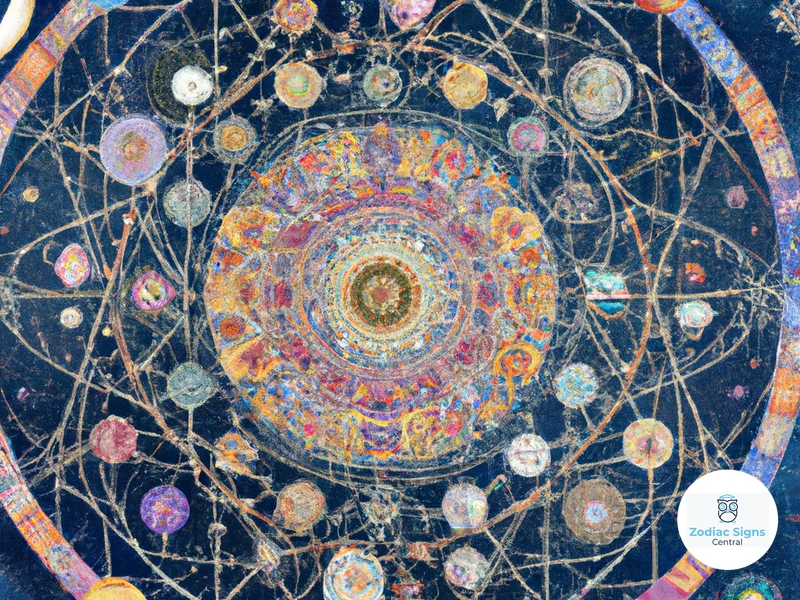
1. Understand the Interplay of Astrological Factors: To ensure accurate birth chart analysis, it’s crucial to consider the interplay between various astrological factors. Examine how planets interact with each other through aspects and conjunctions, and observe how these interactions influence different areas of life. The relationships between the Sun, Moon, and Rising sign are particularly significant, as they shape the core essence of an individual’s personality and self-expression.
2. Use Supporting Tools and Resources: Utilize supporting tools and resources to enhance your birth chart analysis. Astrology software can generate detailed charts with ease, providing additional information on planetary movements and aspects. Online resources, books, and forums can also offer valuable insights and interpretations from experienced astrologers. Engage in discussions, attend webinars, or seek guidance from professionals to deepen your understanding of birth chart analysis.
3. Take Note of Patterns and Stelliums: Look for patterns in your birth chart, such as stelliums, which occur when three or more planets cluster closely together in a particular sign or house. Stelliums can intensify the energies associated with that sign or house and indicate areas of focus and significance in your life. Recognizing these patterns and stelliums can provide valuable insights into your strengths, challenges, and life themes.
4. Consider Transits and Progressions: Keep in mind that birth chart analysis is not static and should be complemented by considering transits and progressions. Transits refer to the current positions of the planets in relation to your birth chart, offering insights into present influences and possible events. Progressions, on the other hand, consider the gradual movement of planets over time, reflecting your evolving personality and life experiences.
By incorporating these tips into your birth chart analysis, you can ensure a more accurate and holistic understanding of the cosmic energies at play in your life. Remember, astrology is an art that requires both knowledge and intuition, so embrace the process with curiosity and an open mind.
1. Understand the Interplay of Astrological Factors
To effectively read and analyze a birth chart, it’s crucial to comprehend the interplay between various astrological factors. Each element in the chart influences and interacts with others, creating a complex web of cosmic energies that shape an individual’s life journey. Here are some key factors to consider:
The Ascendant: The Ascendant, also known as the Rising sign, represents the persona and the outer impression one gives to the world. It influences the individual’s appearance, behavior, and how they are perceived by others. The Ascendant sign sets the stage for the entire birth chart interpretation and adds valuable insight into an individual’s approach to life.
The Sun: The Sun sign holds immense significance in astrology, representing one’s core essence, ego, and vitality. Analyzing the Sun sign can provide insights into an individual’s fundamental motivations, desires, and primary life purpose. It offers a glimpse into their self-expression and how they seek to manifest their identity in the world.
The Moon: The Moon sign governs emotions, instincts, and intuition. It reveals an individual’s emotional landscape, subconscious patterns, and needs for security and nurturing. Understanding the Moon sign can shed light on how an individual experiences and processes their emotions, as well as their reactions to the world around them.
The Planets: Each planet in the birth chart represents different aspects of an individual’s personality and life experiences. For example, Mercury influences communication and intelligence, Venus rules love and relationships, and Mars signifies passion and assertiveness. Each planet’s placement and aspects within the chart offer insights into how these energies manifest in an individual’s life.
The Houses: The houses in the birth chart represent different areas of life, such as career, relationships, home, and spirituality. The planets’ placement within these houses provides information about where and how the energies expressed by the planets are experienced in an individual’s life.
Understanding the interplay of these astrological factors allows for a holistic interpretation of the birth chart. By analyzing how each element interacts, astrologers can paint a comprehensive picture of an individual’s personality traits, life patterns, and potential. It is important to remember that astrology is a multifaceted discipline, and exploring the interplay of astrological factors requires a deep dive into the complexities of the birth chart.
2. Use Supporting Tools and Resources
2. Use Supporting Tools and Resources
When it comes to interpreting a birth chart, there are various supporting tools and resources that can enhance your analysis and provide deeper insights. Here are some of the key resources to consider:
Astrology Software: Utilizing astrology software can simplify the process of calculating and generating birth charts. These software programs often include advanced features, such as detailed interpretations, planetary calculations, and graphical representations of the birth chart. Some popular astrology software options include Solar Fire, Astro-Seek, and TimePassages.
Ephemeris: An ephemeris is a reference book or table that provides the positions of celestial bodies in the sky at specific times. By consulting an ephemeris, you can track the planetary movements and accurately determine the position of planets at the time of birth. This can be particularly useful for in-depth birth chart analysis and forecasting.
Astrology Books and Guides: There is a plethora of astrology books and guides available that cater to various levels of expertise. These resources delve into different aspects of astrology, from understanding planetary placements to interpreting aspects and transits. Some well-regarded astrology books include “The Only Astrology Book You’ll Ever Need” by Joanna Martine Woolfolk and “The Inner Sky” by Steven Forrest.
Online Resources and Forums: The internet is a treasure trove of astrology resources, allowing you to access a wide range of birth chart calculators, interpretive articles, and discussion forums. Websites like AstroSeek, Cafe Astrology, and Astrodienst provide comprehensive tools and resources for analyzing birth charts and learning more about astrology.
Consulting with Astrologers: When in doubt, seeking guidance from professional astrologers can offer profound insights into your birth chart. Experienced astrologers possess deep knowledge and expertise in interpreting birth charts, and their personalized guidance can help you navigate complex astrological concepts and uncover hidden meanings.
Remember, while these tools and resources can enhance your birth chart analysis, it’s essential to approach them with an open mind and discernment. Astrology is a complex field, and interpreting birth charts requires a combination of knowledge, intuition, and personal insights. By utilizing these supporting tools and resources, you can deepen your understanding and unlock the intricate layers of your birth chart.
Conclusion
In conclusion, delving into the world of birth chart analysis can open up a universe of self-discovery and understanding. Through the interpretation of the various components of a birth chart, such as the Ascendant, Sun, Moon, and planetary placements, you can gain valuable insights into your personality, strengths, challenges, and life path. Understanding the interplay of astrological factors and utilizing supporting tools and resources can further enhance the accuracy and depth of your birth chart analysis.
By diving into the symbolism and patterns within your birth chart, you can uncover layers of meaning that resonate with your unique journey. Astrology offers a fascinating lens through which to explore and understand the complex tapestry of your life. It provides a framework for self-reflection, personal growth, and decision-making, empowering you to navigate the ebb and flow of life with clarity and purpose.
Remember that birth chart analysis is not a definitive blueprint, but rather a guide that offers insights and possibilities. It is up to you to consciously engage with the information and apply it to your own life. Embrace the wisdom that astrology offers, while also maintaining your own agency and free will.
So, take a deep breath, trust in the cosmic dance, and embark on this enchanting journey of exploring and understanding your birth chart. May it be a tool that brings you clarity, self-awareness, and a deeper connection with the mysteries of the universe.
Frequently Asked Questions

1. What information do I need to gather to create a birth chart?
To create an accurate birth chart, you’ll need the date, time, and place of your birth. The date and place determine the positioning of the celestial bodies, while the time is crucial for determining the Ascendant, Moon, and other important placements.
2. How do I find out my Ascendant?
Your Ascendant, or Rising sign, is determined by the specific time of your birth. It represents your outward personality and how others perceive you. To find out your Ascendant, you can use online birth chart calculators or consult an astrologer.
3. What does my Sun sign represent in my birth chart?
Your Sun sign represents your core essence, ego, and identity. It signifies your unique strengths, talents, and the fundamental qualities that drive your life purpose and creative expression.
4. What does my Moon sign reveal?
Your Moon sign represents your emotions, intuition, and subconscious mind. It reflects your emotional needs, innermost desires, and how you respond emotionally to different situations in life.
5. What do the planetary placements signify in a birth chart?
The planetary placements in your birth chart reveal how the different celestial bodies influence various areas of your life. Each planet carries its own energy and symbolism, influencing different aspects such as communication (Mercury), love (Venus), and ambition (Mars).
6. What are aspects and conjunctions in a birth chart?
Aspects refer to the specific angles formed between planets in a birth chart. They reveal the relationships and interactions between different energies. Conjunctions, in particular, indicate planets that are close together and amplify their combined effects.
7. How do elements and modalities come into play in a birth chart?
The elements (fire, earth, air, and water) and modalities (cardinal, fixed, and mutable) provide insights into your personality traits and how you approach life. They reveal your natural tendencies, strengths, and areas where growth and balance are needed.
8. What are birth chart patterns?
Birth chart patterns refer to specific arrangements of planets and aspects in a chart. Common patterns include stelliums, grand trines, and T-squares. These patterns offer additional layers of interpretation and highlight specific themes or challenges in an individual’s life.
9. How can I improve my birth chart analysis?
To enhance your birth chart analysis, it’s important to understand the interplay between different astrological factors. Consider the relationships and connections between planets, houses, and signs. Additionally, using supporting tools and resources such as astrology books, online forums, and consultations with experienced astrologers can deepen your understanding.
10. Can my birth chart predict my future?
While a birth chart provides valuable insights into your character and life patterns, it’s important to note that astrology does not provide a definitive forecast of the future. Instead, it offers guidance and a framework to understand the energies at play and make informed choices to shape your own destiny.
References
Frequently Asked Questions

1. Can anyone read and analyze a birth chart?
Yes, anyone can learn how to read and analyze a birth chart with the right guidance and resources.
2. How accurate are birth chart readings?
The accuracy of birth chart readings depends on the skill and expertise of the astrologer conducting the analysis. A knowledgeable astrologer can provide valuable insights based on the birth chart.
3. What is the significance of the ascendant in a birth chart?
The ascendant, or rising sign, represents the individual’s outward personality and how they appear to others. It plays a crucial role in understanding the individual’s overall life direction.
4. Can the sun sign alone determine someone’s personality?
While the sun sign is an essential element in astrology, it is not the sole determinant of a person’s personality. The birth chart takes into account various planetary positions and placements for a more accurate analysis.
5. How do planetary placements affect someone’s life?
Planetary placements in a birth chart influence different aspects of a person’s life, such as their career, relationships, and general temperament. Each planet holds specific energies and qualities that impact various areas of life.
6. What are aspects and conjunctions in a birth chart?
Aspects and conjunctions refer to the relationships between planets in a birth chart. They indicate how planets interact with one another and can provide further insights into an individual’s personality traits and life experiences.
7. How do the elements and modalities in the birth chart affect personality?
The elements (fire, earth, air, and water) and modalities (cardinal, fixed, and mutable) in the birth chart reveal different qualities and characteristics of a person’s personality. They indicate how individuals express themselves, handle challenges, and interact with others.
8. What are birth chart patterns, and how do they impact a person’s life?
Birth chart patterns, such as stelliums, grand trines, and yods, reveal unique arrangements of planets in a birth chart. These patterns can influence an individual’s life in specific ways, highlighting their strengths, challenges, and potential life paths.
9. Are there tools or resources available to support birth chart analysis?
Yes, there are various tools and resources available to support birth chart analysis. Astrology software, online birth chart calculators, and books on astrology can provide additional insights and assist in interpreting complex birth charts.
10. Can the birth chart change over time?
The birth chart remains constant throughout an individual’s life. However, the planetary transits and progressions can influence the energies and experiences associated with different aspects of the birth chart as time progresses.

